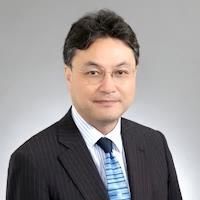The Rio 2016 Culture Programs: Observation Report and Hints for Tokyo 2020
0. Introduction: The Stakeholders of the Rio 2016 Olympics' Culture Programs
For roughly two weeks starting in mid-August of this year (2016), I stayed in Rio de Janeiro (below, Rio) at the request of the Tokyo Arts Council, and was blessed with the opportunity to observe and survey the thirty-first Olympic Games (2016 Rio de Janeiro) (hereinafter, , "Rio 2016"), primarily with regard to its culture programs. *1 Below is my observation report regarding them.
*1: I carried out a ground survey along with Mitsuhiro Yoshimoto (NLI Research Institute). His report, entitled "Rio 2016 hōkoku: bunka puroguramu o chūshin ni" (Rio 2016 Report: Cultural Programs) is available at the following address (in Japanese): http://www.nli-research.co.jp/report/detail/id=54039?site=nli.
There were four major stakeholders in the Rio 2016 cultural programs: the Rio 2016 Organising Committee, Brazil's federal government, the state of Rio, and the city of Rio. While I will discuss the characteristics of their individual programs below, speaking generally, there was almost no effort to coordinate between stakeholders; each was involved on its own. This differed considerably from the structure of the London 2012 cultural programs, which were characterized by the organizing committee and the city of London making sure to cooperate (including with regard to personnel) as well as the Arts Council providing comprehensive underlying support on the ground for the events carried out throughout the country. In the background to this year's situation lay a structural problem: there is no arts council in Brazil that serves as a specialized organization to constantly support culture and the arts. Below, I will consider how each stakeholder carried out their cultural programs—or why they did not.
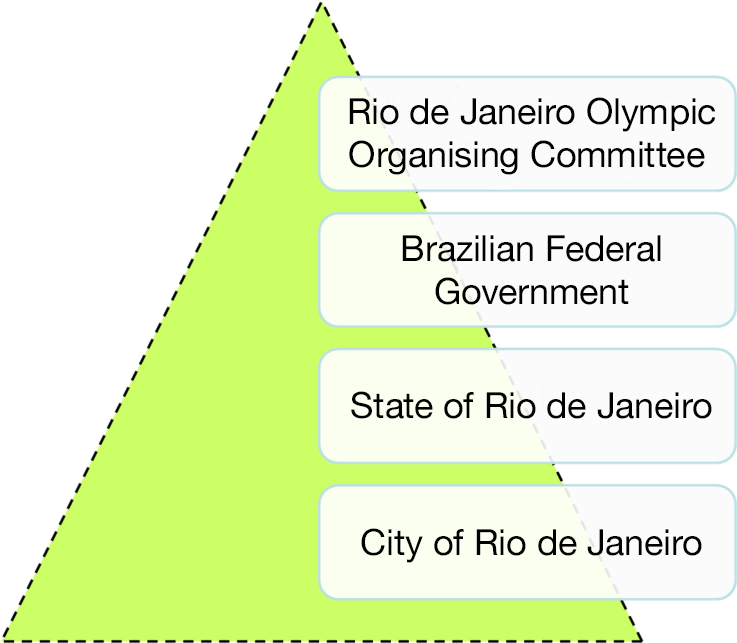
1. The Rio 2016 Organising Committee
Carla Camurati is an actor, film director, and very recently began working as the artistic director of Rio's Municipal Theater. The organizing committee appointed her as its director of culture, planning to carry out a cultural program. This was the same position occupied by Ruth Mackenzie for the 2012 London Olympics.
In April 2015, a flash mob was organized in the city of Rio to mark five hundred days until the Olympics. As of July of the same year, the organizing committee had announced plans for a cultural program that would introduce culture into urban spaces (roads, squares, parks, beaches, etc.) to capture the fascination of "Carioca" (Rio residents) and tourists. *2
The organizing committee's Rio Olympics cultural program was named "Celebra" (celebration), and at first various cultural events were envisioned in order to highlight the diversity of Brazilian culture. The below logo was also designed. This corresponded to the London Olympics' "official cultural program" and its non-profit cultural program "Inspire." In Rio, there were plans to have official Celebra events use both the Olympic / Paralympic logos and the Celebra part, and non-profit ones only the latter.

A Japanese artist's piece was also included in Celebra's official cultural program: Mariko Mori's "The Ring: One With Nature," which used Celebra's official logo, was placed above the "Veu da Noiva" waterfall in the city of Mangaratiba (state of Rio). *4
*4: Rio 2016 "Conheça os projetos do Celebra, programa de cultura dos Jogos Rio 2016" (August 17th, 2016).
However, excluding the above-described events and the opening and closing ceremonies at the Olympic Stadium, basically nothing was carried out as part of the organizing committee's cultural program. This was due to a lack of funds, personnel, and human resources.
With regard the lack of budget, according to a Reuters report, immediately before the Olympics began (July 2016) the organizing committee was "running a deficit of between 400 million and 500 million reais ($121 million to $151 million)" caused by "rent for the Olympic Village, where thousands of athletes will stay," and "smaller-than-expected sponsorship funding by Brazil's state-run oil company Petrobras, whose fortunes soured amid low oil prices and a corruption scandal." *5
*5: "Rio Olympics local committee has deficit of up to $151 million – source," Reuters (July 12th, 2016).
When I interviewed an individual involved in the cultural program, they memorably commented that the situation was "like a nightmare."
2. The Brazilian Federal Government
In May 2015, the Brazilian Federal Government announced that they planned to hold a cultural program comprised of a total of two thousand events carried out by ten thousand artists in eighty places in the city of Rio. It was expected that they would cost eighty-five million reais. *6 *7
*6: Approximately 2.8 billion yen (1 real at 33 yen).
*7: Brazilian Federal Government "Conheça a programação cultural dos Jogos Rio 2016" (May 4th, 2016).
The Ministry of Culture announced on July 29th, 2016 that there would be 561 events, that two thousand artists would participate, as well as that it had secured eighty-five million reais, fifty thousand of which was already being spent on its culture program. *8
*8: Brazilian Federal Government's Ministry of Culture "Diversidade cultural brasileira será apresentada no RJ"(July 29th, 2016)
In order to carry out such a cultural program, Jose Mauro—who had already worked for over ten years as the director of the "Virada Cultural" cultural event that had made use of public spaces in the city of San Paulo—was appointed as cultural program artistic director in January 2016 in light of his accomplishments.
Mauro stated that since Rio city's cultural program was centered on the port district (see below), he envisioned carrying out events in other areas that made of use of buildings and public spaces owned by the federal government. Mauro's idea was to invite artists from throughout Brazil in order to incorporate into his program the country's regional cultural diversity, as well as hold a cultural parade and make use of large-scale projection mapping. This would all be free so as many people could participate as possible. He also envisioned events in the Olympic stadium that shared the richness of Brazil's cultural when competitions were not being held. *9
*9: Jose Mauro interview (August 23rd, 2016).
However, the situation completely changed in June due to President Rouseff being suspended from her position. According to a BBC report, one of the first measures of the new center-right administration that took power after Rouseff lost year job was to eliminate the federal government's Ministry of Culture as part of austerity measures.(!) However, as many as several hundred artists occupied the ministry's building in Rio, set up tents in its courtyard, and held incendiary performances for the people every night. Furthermore, subsequently a large-scale demonstration was held. The administration thus decided to not abolish the ministry. *10
*10: "Rio 2016: The 'Secret' Cultural Olympiad," BBC (July 29th, 2016).
Amidst this situation, immediately before the Olympics began, in July the federal government decided to halt a large portion of its cultural program. This was decided in light of the delicate political situation, which continues today. It was done to dispel concerns that if large-scale cultural events open to the general public were held in outdoor public spaces for free, those in attendance would turn into a mob and hold anti-government demonstrations. According to Mauro, excluding projects that had already been paid for and the like, approximately eighty percent of the culture program was discontinued. Maruo himself resigned from his position as artistic director in July.
While it is unclear if this falls under the twenty percent of the cultural program carried out by the federal government, the "Art Monument Brazil 2016 Olympic 2016," which accepted works submitted by the public, was carried out. Its theme was the intersection of sports and art. Twenty-three works were recommended out of the 281 that were submitted, and financial support was provided so that they could be created. The chosen works covered a wide swath of genres, from monument sculpture to short film. Works were required to be finished within the year. *11
*11: Jo Takahashi, "Ima, Burajiru wa sekai ni mukete āto o hasshin suru" [Now, Brazil Shares Art with the World] (August 2016).
3. The State of Rio
On June 17th, 2016 it was reported that the state of Rio de Janeiro "declared a state of financial emergency Friday and requested federal funds to help fulfill obligations for public services during the Olympics that start Aug. 5." *12
*12: "Rio State Declares Financial Emergency, Requests Funding for Olympics," Reuters (June 18th, 2016).
Under this declaration of emergency, the state probably was unable to carry out any part of its cultural program. In fact, when interviewing affiliated individuals on the ground, all commented that the state probably did not. Searching the internet, I was unable to find any information indicating that it was.
As we have seen above, the organizing committee, federal government, and state of Rio all did not really carry out their cultural programs. According to the daily newspaper O Globo, as of two weeks before the opening ceremony the only cultural program that was definitely going to be held was the one run by the city of Rio. *13
*13: "Governo federal cancela atrações e programação cultural na Olimpíada segue um mistério," O Globo (July 22nd, 2016).
4. Rio City
The program of Rio city can be generally divided into two parts: that of (1) the Cultural Division, and (2) the cultural redevelopment of the port area.
(1) Rio Municipal Cultural Division's Project
Rio Municipal Cultural Division's project consisted of two parts: a supply-side approach and a demand-side approach.
Figure 3: Overall Structure of Rio Municipal Cultural Division Cultural Program Project
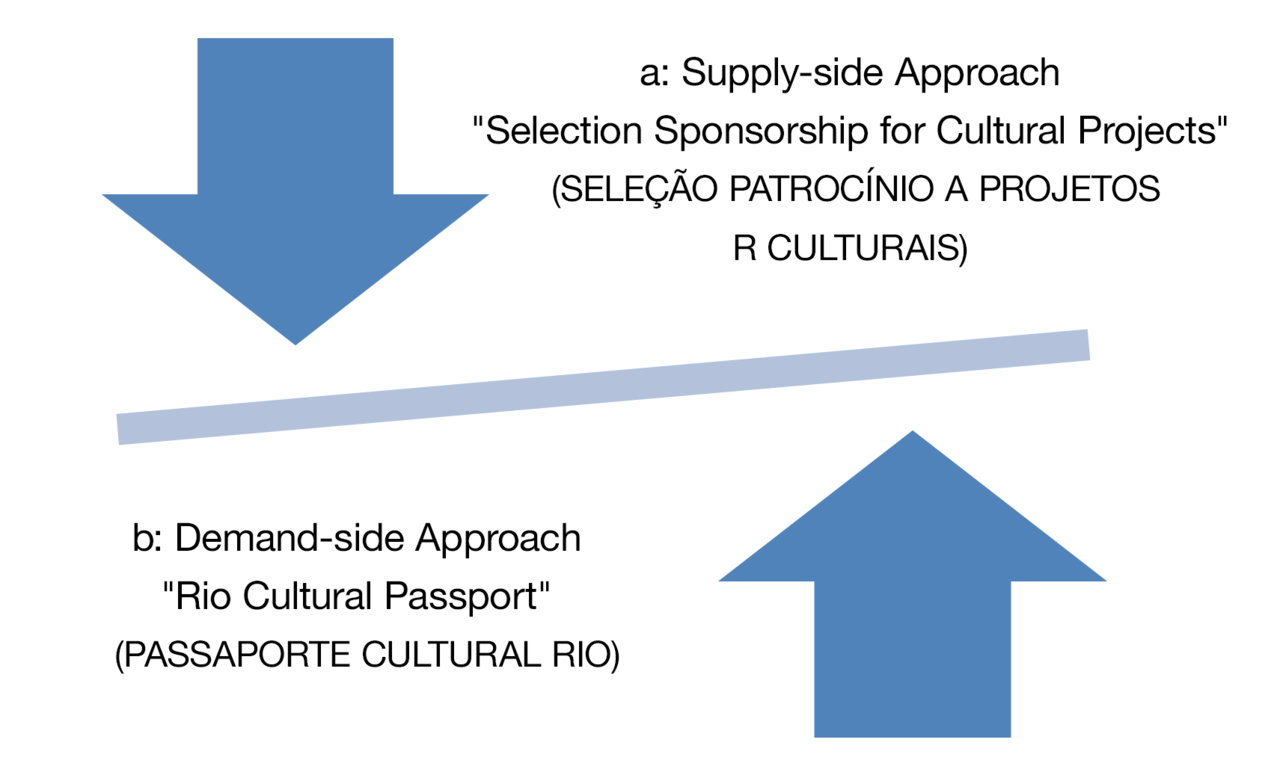
For the former, Rio city used a system called the "Selection Sponsorship for Cultural Projects" (SELEÇÃO PATROCÍNIO A PROJETOS R CULTURAIS). Applications for cultural projects were accepted from the public, and funding was provided to those that had passed a screening. Applications were accepted from August 3rd to October 18th, 2015. 1,078 were received, at 153 passed the screening (acceptance rate: 14.2%). Over 130 of these received between fifty to one hundred reais for a total of ten million reais. The genres were diverse, covering theater, film, literature, and more.
Figure 4: "Selection Sponsorship for Cultural Projects" Overview
| Type of Cultural Project | No. Passing Screening |
Total Budget |
|---|---|---|
| Projects at public facilities | 26 | Two hundred thousand reais |
| Projects at private facilities | 23 | Two hundred thousand reais |
| Projects with no entrance fee (or less than 30 reais entrance fee) | 25 | Two hundred thousand reais |
| Projects run by general citizens (not belonging to a group) | 68 | Three hundred thousand reais |
| Projects for disabled individuals
(Condition: over one half of member must have a disability)
|
11 | One hundred thousand reais |
| Total | 153 | One hundred thousand reais |
(Source: Created by author based on Rio Municipal Cultural Division 2015 no. 6 Rules *14)
*14: Rio City "REGULAMENTO DO PROCESSO DE SELEÇÃO PATROCÍNIO A PROJETOS R CULTURAIS" (October 2015).
As a result, as part of the city's cultural program, 2,228 projects were carried out while the Olympics (August 5th to 21st) and 1,306 while the Paralympics (September 7th to 18th) were being held. Below I have listed the major ones *15 While the "Vero" poster was displayed throughout the city, the Celebra logo was not used, and there was nothing in writing that indicated that it was related to Rio 2016.
*15: Materials provided by Rio City.
Figure 5: Rio City's Major Cultural Program Projects
| Name | Date Carried out | Overview |
|---|---|---|
| Metaesquema | August 6th | Based on the works of the Rio native Helio Oiticio—whose works were also displayed at the National Museum of Modern Art, Tokyo during the 2008 exhibit "Neo Tropicalia: Contemporary Art in Brazil"—the circus group Anima Circ carried out free-interpretation performances. Some group participants are graduates of a social program for poor youth that live in slums (favela). |
| Fest-Favera | July 30th to August 8th |
The theater group GENE INSANNO COMPANHIA DE TEATRO (est. 1994) held comprehensive art festivals comprised of dance, theater, music, and more in five large slums (favela). |
| Vero | In August? | A dance performance directed by director Deborah Colker, who helped choreograph and stage the Olympic games' opening ceremony. Her "Belle" was performed in 2016 at the Kanagawa Arts Theater. |
| Corcovado Christ Statue: Sacred Geometry | July 30th to October 2nd |
An exhibit created by Oskar Metsavaht, the creative director of Rio de Janeiro's New Luxury brand "Osklen" (which has stores in Aoyama, Tokyo). Held at the newly renovated Rio History Museum. |
| Black Bom Party | August 20th | A pocket-sized version of the Afro-Brazilian music party Black Bom. It aimed to secure the status of Afro-Brazilians in society. |
| Sabastiano | Until August 28th | Performances inspired by short stories of author João do Rio, a native of Rio. It was a movement-based event that brought viewers to various places in the city, such as the old café Colombo and a "funky party" on the outskirts of town. |
(Source: Created by the author based on materials provided by Rio city)
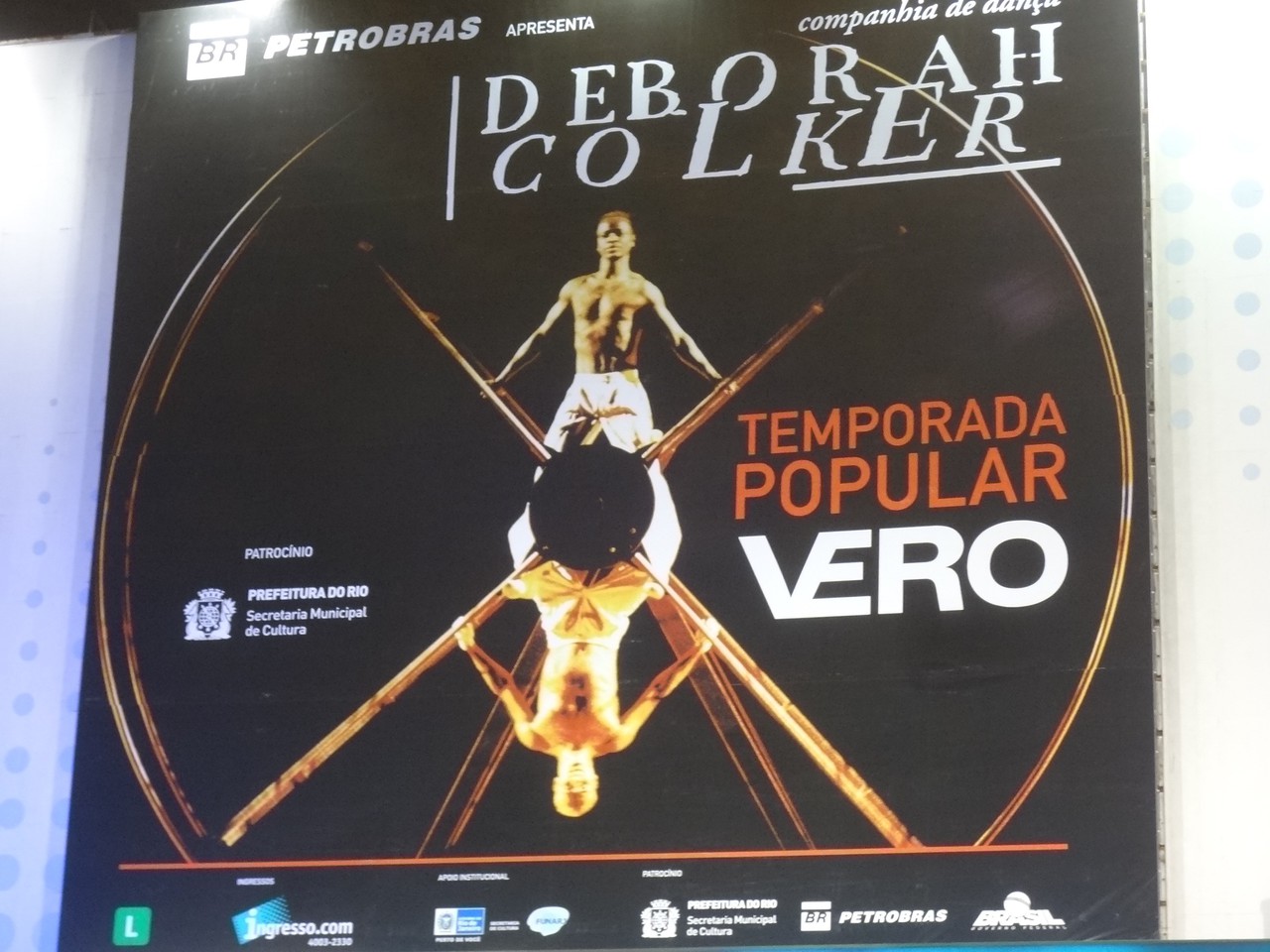
(Source: Photographed by author)
As for the city's demand-side approach, in order to increase people's involvement with culture, the "Rio Cultural Passport" (PASSAPORTE CULTURAL RIO) was introduced.
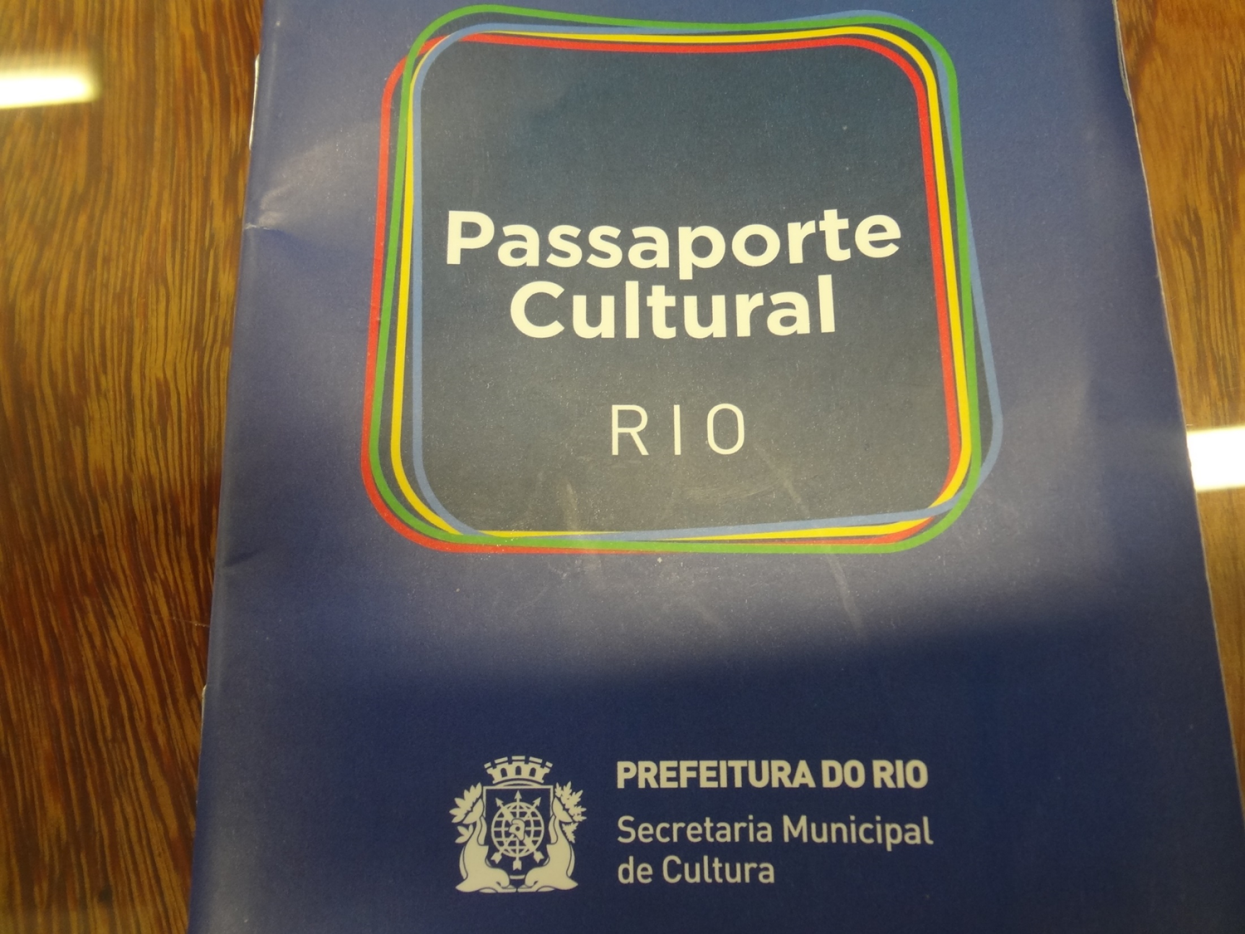
This passport was provided via the Internet for free to Brazilians and for 15 reais to foreigners. Holders of the passport could enjoy exhibits, lectures, and the like at Rio municipal as well as participating private cultural facilities for free or half price or less. Rio city did not reimburse such facilities for these discounts. This was because it was hoped that the passport would increase their numbers of visitors, thereby spurring associated consumption (for example, pamphlet, food, or drink purchases), as well as raise the number of repeat visitors in the mid-term. Approximately two hundred thousand passports were issued. In Brazil there are a total of twenty-seven states if one includes the Federal District (where Brasilia is located), and all of their residents applied for and received the passport. Incidentally, the head of the Cultural Division who proposed this is a former diplomat. Making use of a "passport," it is was rather diplomat-like undertaking. *16
*16: Interview of Junior Perim, the head of the Rio Municipal Cultural Division (August 22nd, 2016).
However, immediately before Rio 2016 began, the Rio Cultural Passport stopped being issued. Its official website stated that it was due to the judgment of a local elections court. According to the Brazilian daily newspaper O Globo, the judge in charge of observing election activities for the state of Rio ordered on August 10th that the Rio Cultural Passport stop being issued because state law (9504/97) prohibits a government administrative agency from providing free services or goods to the electorate during the year of a gubernatorial election unless they receive legal permission in advance and do not begin doing so in the previous financial year. While the federal government's Public Prosecutor's Office demanded that the issued passports be collected, the court rejected this. *17
*17: "Juiz eleitoral suspende programa cultural da Prefeitura do Rio" O Globo (August 10th, 2016)
Each year of this four-year cultural program, the head of the Rio Municipal Cultural Division changed, and thus could not carry out the program in a sustained fashion. The current head was a political appointee that assumed the post in May 2016, in other words, immediately before the games began.
(2) Cultural Redevelopment of the Port Area
While being its birthplace, Rio's port area had previously had been characterized by rows of abandoned warehouses, gatherings of homeless people, and drug sales. It was desolate and dangerous. A project, called "Porto Maravilha" ("Miracle Port"), was carried out that used the games as an opportunity to regenerate the port as a cultural area via redevelopment.
The "Porto Maravilha" project sought to redevelop fifty million square meters, and included the Art Museum of Rio, the Museum of Tomorrow, and other cultural facilities. Furthermore, it also featured the building of four tunnels to improve access from the center of the city. In total 8.2 billion reais were invested. *18
*18: Brazilian Federal Government "Plano de Políticas Públicas" (April 2015).
The project area was redeveloped via a public-private partnership: selling additional development rights (Certificados de Potencial Adicional Construtivo) to private companies, and then using the resulting funds for public infrastructure development and the conservation of historical and cultural heritage. It was overseen by the Rio De Janeiro Port Area Urban Development Company (Companhia de Desenvolvimento Urbano da Região do Porto do Rio de Janeiro). *19
*19: Takashi Yamada, "Haigo chiku no saikaihatsu ga kitai sareru Rio de janeiro wan" [The Port of Rio de Janeiro: Expected Back Area Development] (April 2014).
The primary cultural elements created in the area included the Art Museum of Rio, Museum of Tomorrow, the world's largest graffiti art, the Rio 2016 Olympic cauldron, "live sites," and hospitality houses (the latter will be described below.) Below I have provided an overview of them.
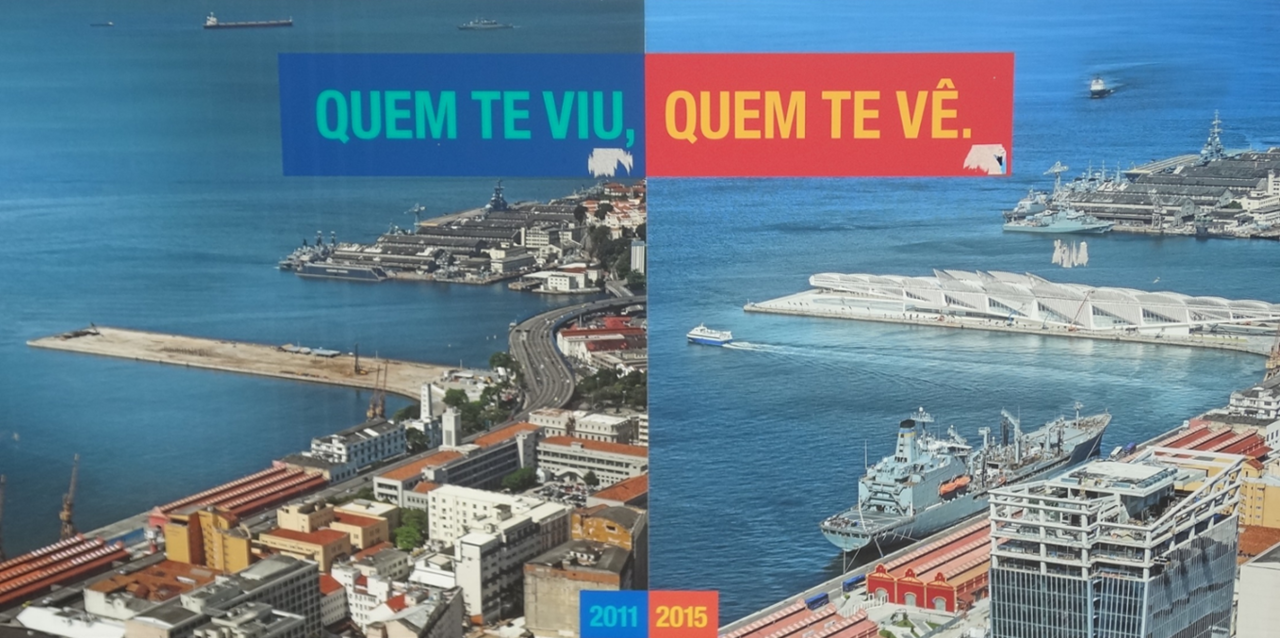
The Art Museum of Rio (Museu de Arte do Rio), completed in March 2013, was a redevelopment project that connected a modern building (formerly a bus terminal) with the neighboring "Little Palace Dom João VI" (Palacete Dom João VI). João VI (1767-1826) was a regent of Portugal, and in order to escape Napoleon's invasion, upon the death of his mother Maria I in 1816 he became the king of Portugal in Rio de Janeiro. In other words, Rio 2016 was held exactly two hundred years since his ascension to the throne.
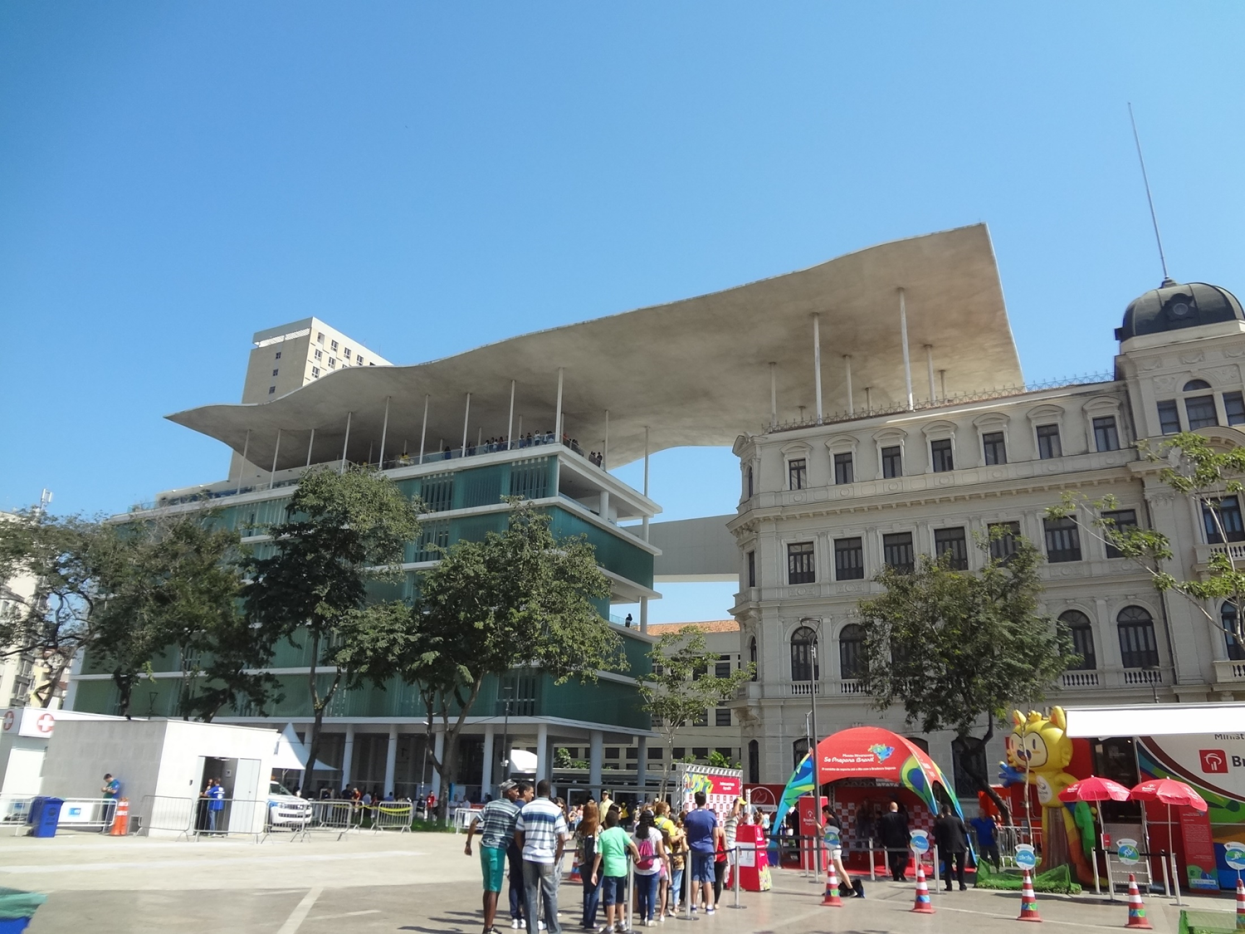
The Museum of Tomorrow (Museu do Amanhã) is a science museum centered on sustainability that was designed by the Spanish architect Santiago Calatrava Valls, who also designed the main stadium for the 2004 Athens Olympics. Before the games were held, displayed on the walls of the museum were thirteen posters commissioned by the organizing committee from artists who were recommended by individuals in the art world. *20
*20: "Riokko no regashii / 4 āto mo tayō" [The Legacy of Natives of Rio / 4 The Art is Diverse Too], Mainichi Shimbun (July 25th, 2016).
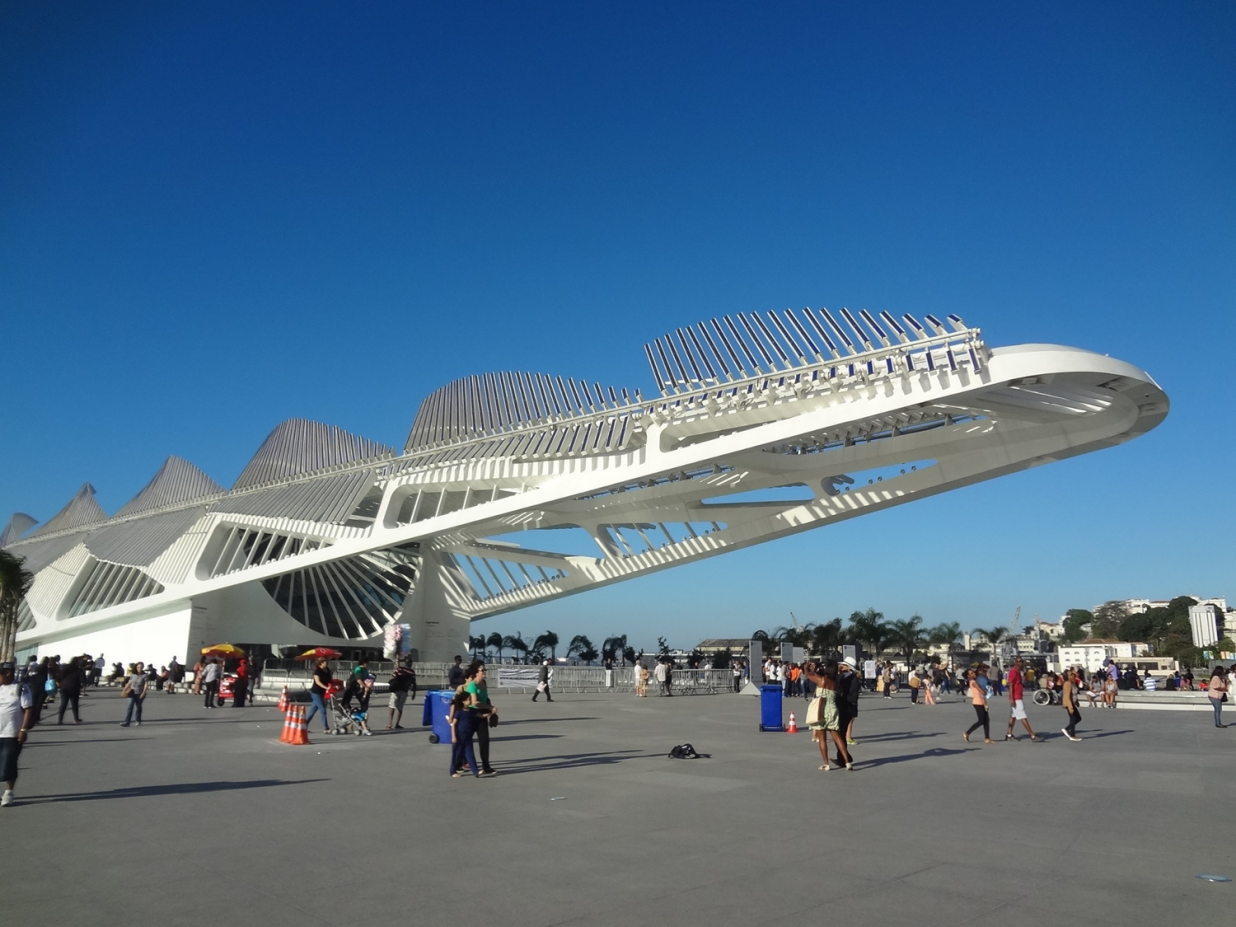
Part of this port project can be found in the Guinness Book of World Records: Eduardo Kobra's "Ethnicities Mural," a 170 meter wide and fifteen meter tall piece of graffiti art that depicted the native inhabitants of the world's five continents, was registered as the world's largest mural. The five faces found therein are Papa New Guinea's Huli (Oceania), Ethiopia's Mursi (Africa), Thailand's Kayin (Asia), Europe's Supi, and Americas' Tapajós. In addition to twenty-eight thousand cans of spray paint, it also required 180 cans of acrylic paint and seven lifts. *21
*21: "Koburashi no hekiga Ginesu ni, go tairiku no senjūmin no kao egaku, gorin de umareta bunka sakuhin" [Kobra's Mural Registered in the Guinness Book of World Records - Depicts Native Peoples of the Five Continents - A Cultural Piece Born from the Olympics], Nikkei Shimbun (August 25th, 2016).
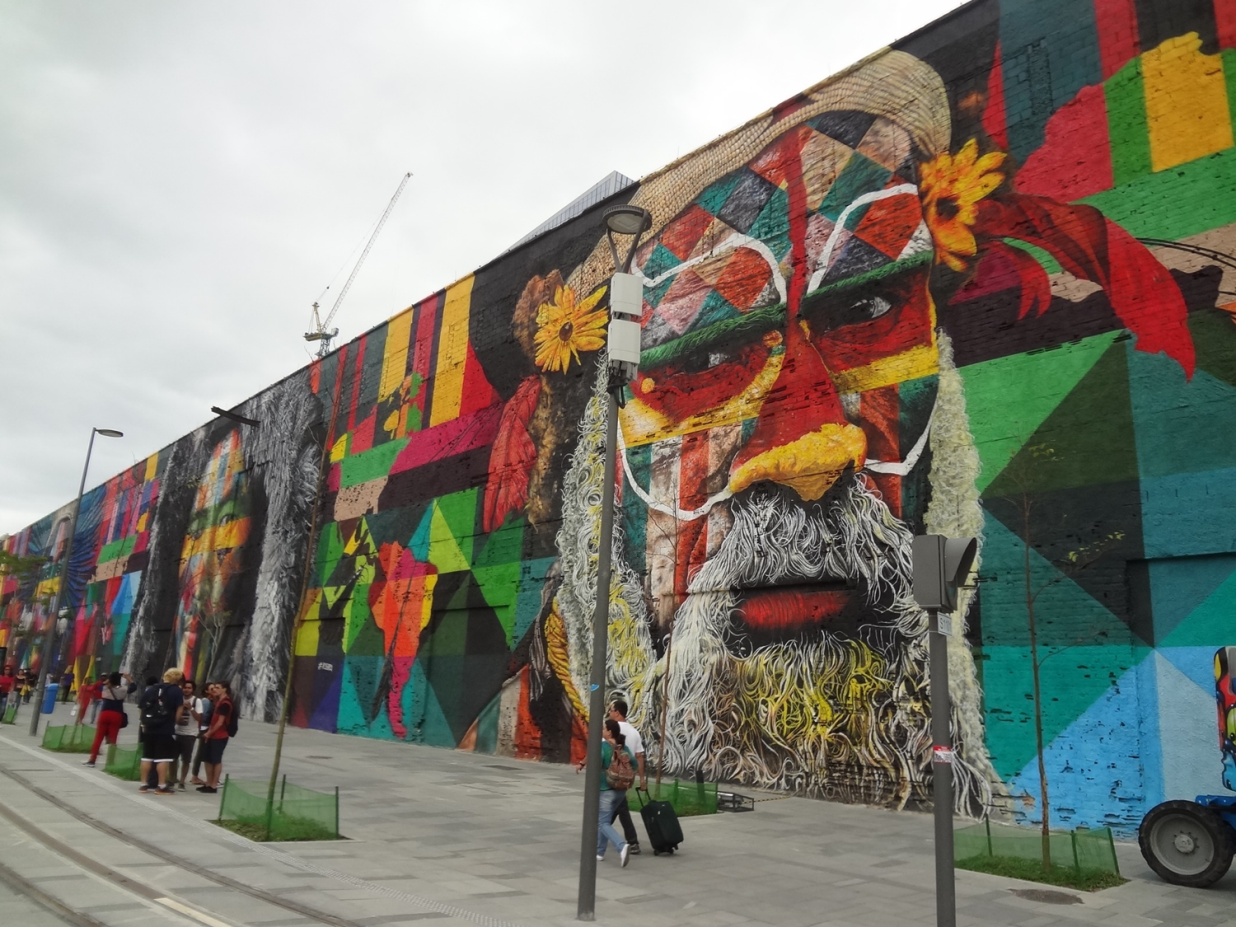
Next to this giant graffiti art is an installation by the French artist JR entitled "Inside Out." This work consists of enlarged photographs of various people's faces pasted on the wall of a building. JR has used this technique in France, Japan, and other countries throughout the world.
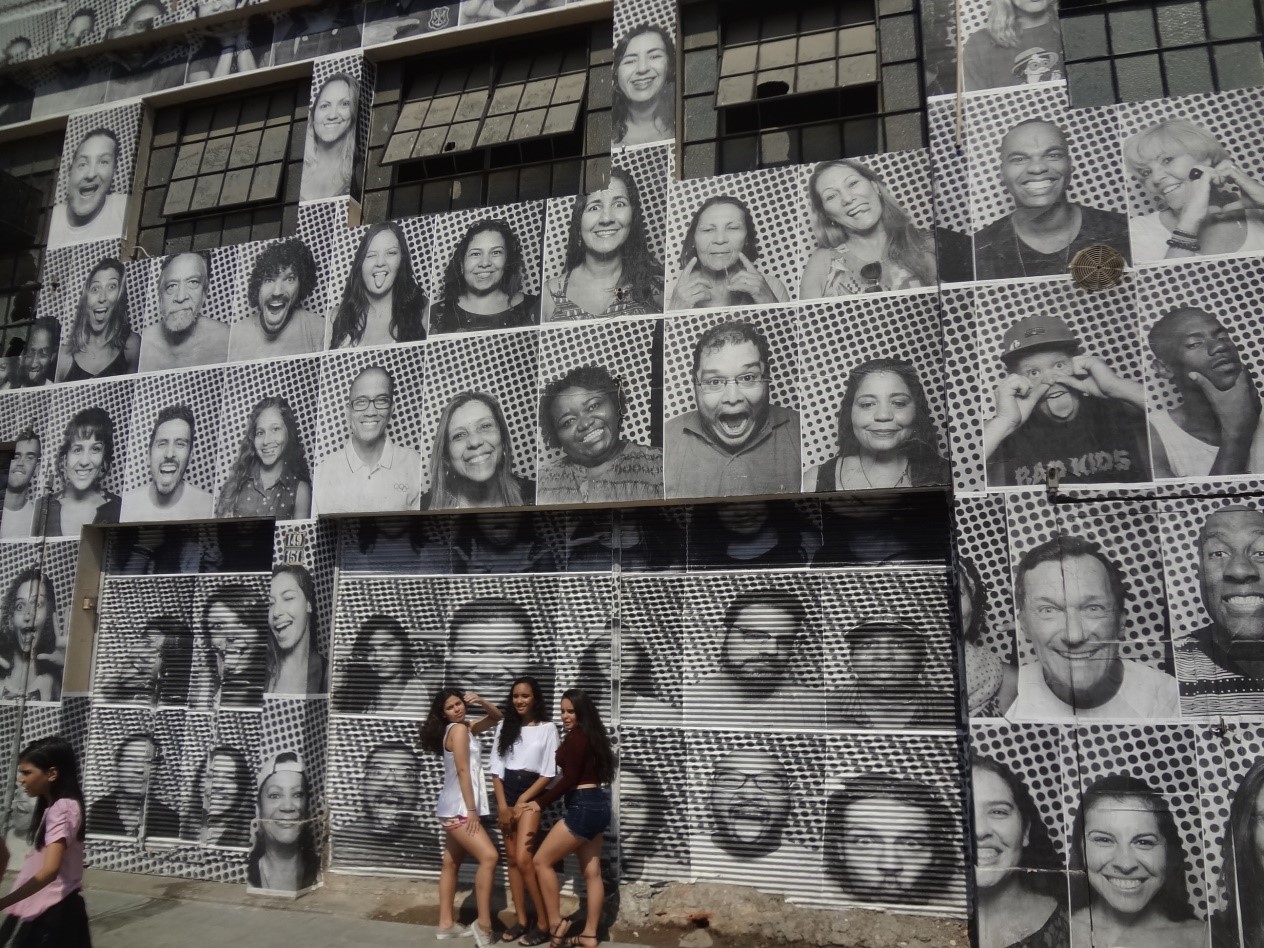
The Rio 2016 Olympic cauldron was a piece of kinetic art by the American artist Anthony Howe. At Rio 2016, a second small Olympic flame was installed in the port area since most people could not see the one in the stadium for themselves. In fact, the Olympic cauldron in the port area was very popular amongst Rio citizens and tourist, and was an ideal photo spot.
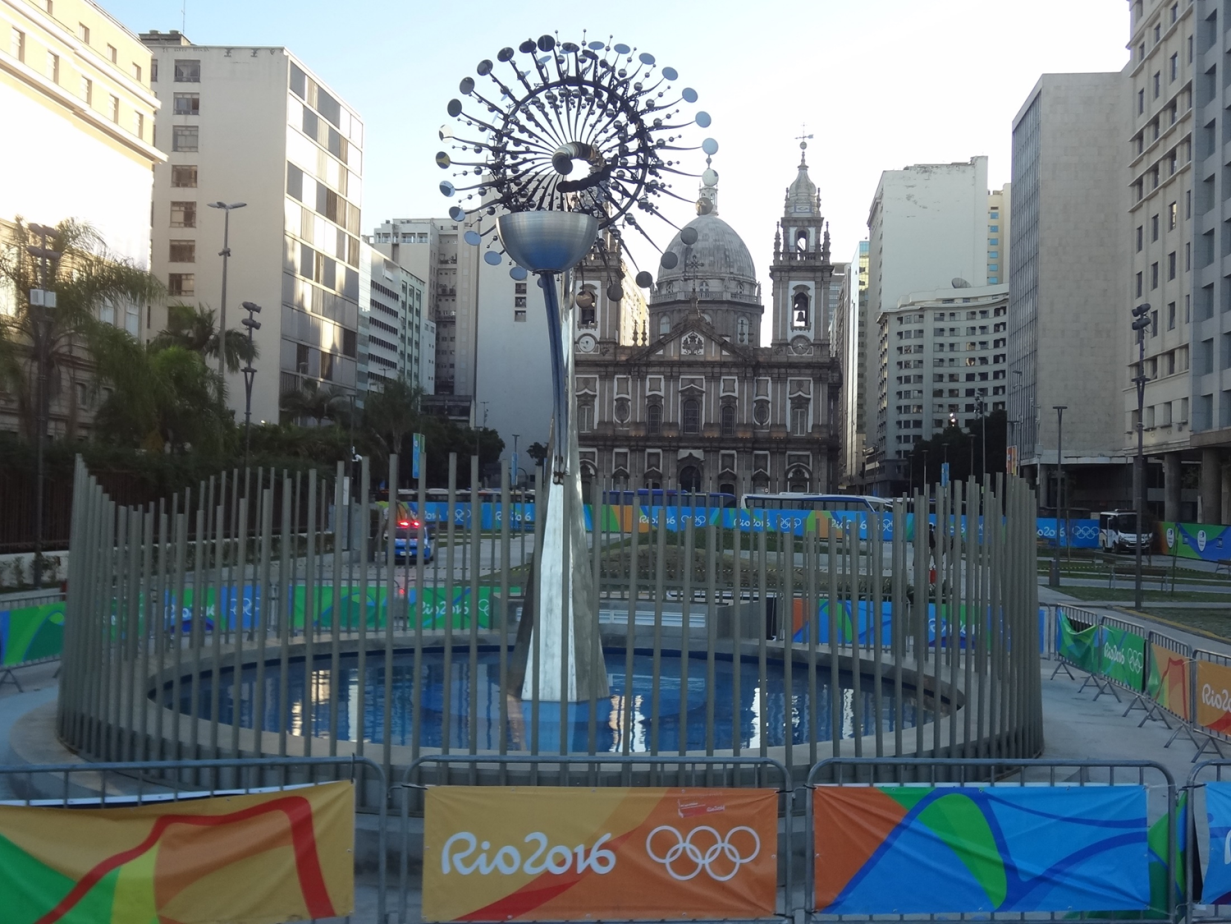
Furthermore, there were three "live sites" opened in the port area while the games were being held. In addition to live broadcasts of the various Olympic sporting events, there were live music and dance performances during downtime. During Rio 2016, a total of over eighty of them were held and could be seen at no charge.
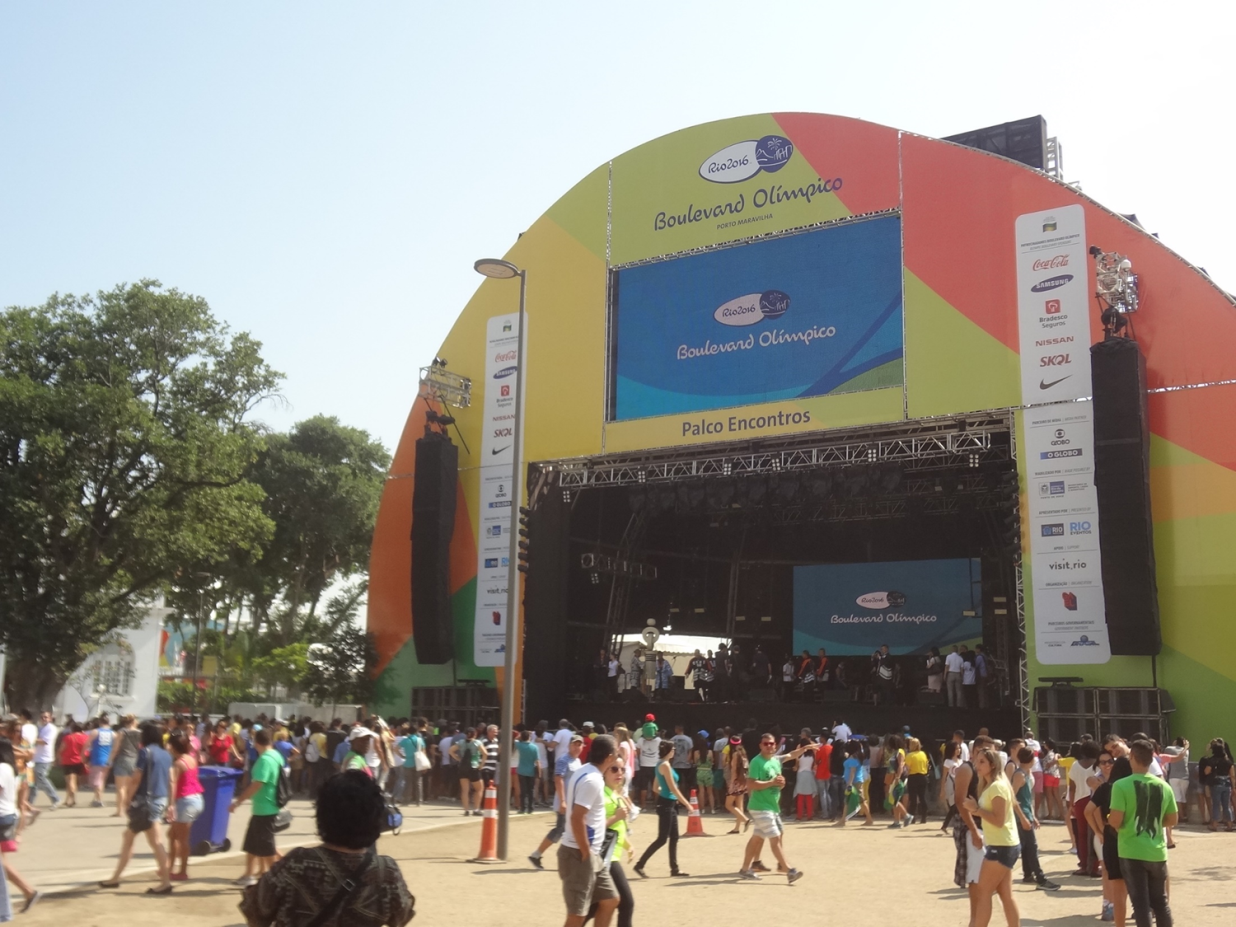
5. Rio 2016 Olympic Culture Programs' Characteristics and Hints for Tokyo 2020
As described above, during Rio 2016 cultural programs were basically not carried out. Of course, it is not appropriate for Tokyo 2020 to adopt this standard: a developing country's first Olympic games and a developed country's second (third) Olympic games are different in nature.
In his Tristes Tropiques (1973[1955]), a travelogue that includes descriptions of visits to Brazilian minority groups in the 1930s, the French cultural anthropologist Claude Lévi-Strauss calls Brazil the "antipodes." This means "the other side of the earth." He said that Brazil was "radically different" and "the exact opposite" of things in his country (Levi-Strauss 1973[1955]: 55). For Tokyo 2020, Rio 2016 was the "antipodes."
Therefore, below I will consider the cultural characteristics of Rio 2016 and present suggestions for Tokyo 2020. When doing so, I will use three keywords that express the characteristics of Brazilian culture: gambiarra, antropofagia, and jogo de cintura. *22
*22: These three keywords were suggested by the artist Jum Nakao. He was one of the four artists who participated in "CULTURE & TOKYO in RIO 'Turn,'" which was held in Rio during the Olympics.
(1) Gambiarra and Hints for Tokyo 2020
Gambiarra means using what is available to address an issue when it comes up in a resourceful or creative fashion.
As described above, while almost no official cultural programs were carried out, in my interviews with an affiliated individual, they did not seem to mind, bragging that while there were certainly few special events, the streets of Rio were filled with graffiti pieces, turning the town into a museum. This attitude is a result of the gambiarra spirit.
In fact, there were an innumerable number of graffiti pieces overflowing throughout Rio. In February 2014 a municipal ordinance called "Graffiti Rio" went into effect, deeming March 27th the birthday of the leading graffiti artists Alex Valluri (b. 1987) "Graffiti Day." *23
*23 "'Gurafiti wa geijutsu da: Rio shichō ga kōshiki ni mitomeru'" ["Graffiti is Art": Officially Recognized by Rio Mayor], Nikkei Shimbun (February 28th, 2014).
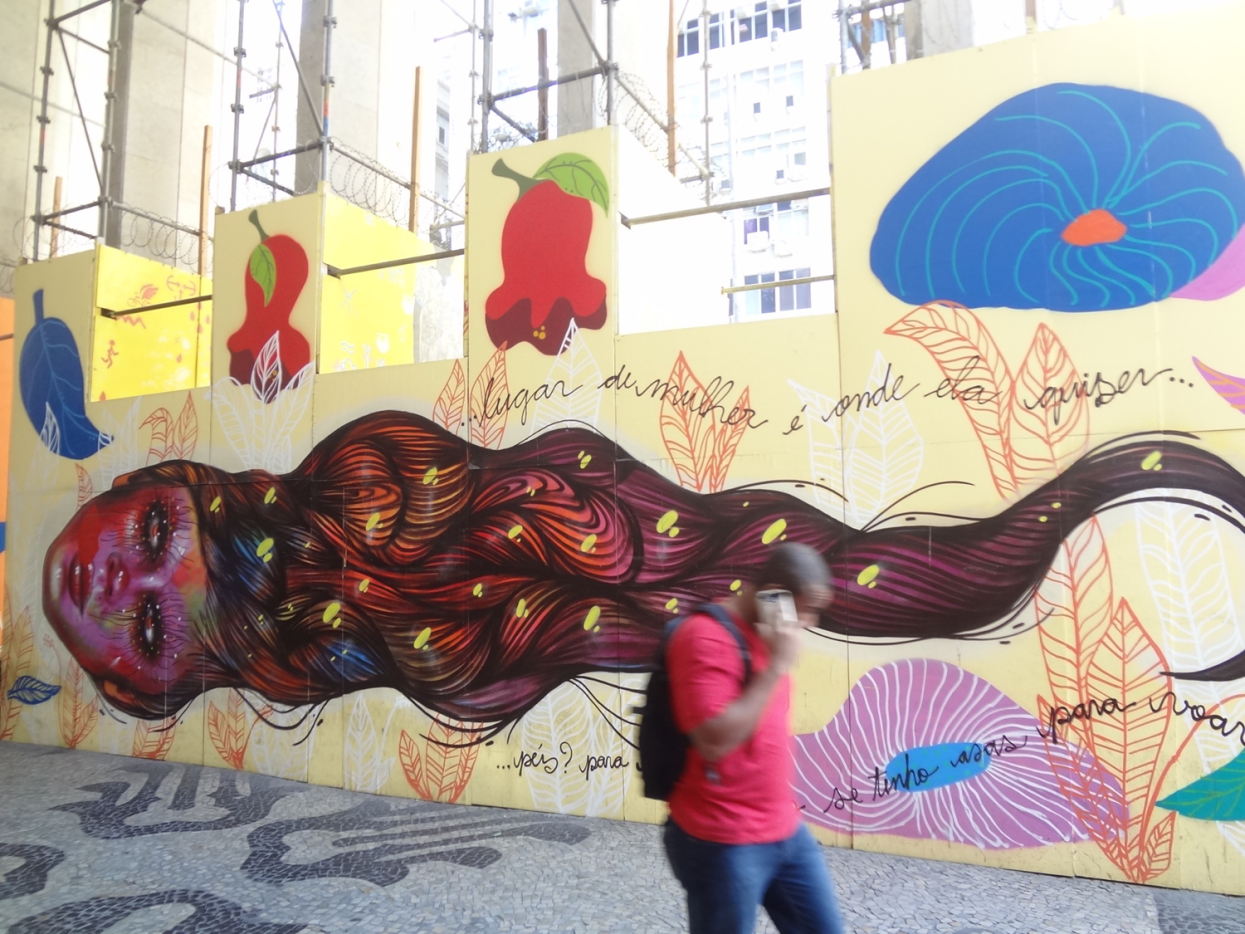
I am not suggesting that the streets of Tokyo be filled with graffiti, but rather proposing that while referring to this example, cultural programs be carried out in unusual places throughout the city, not only existing cultural facilities.
The London 2012 cultural programs included multiple "art in unusual places" projects. "The Fire Garden" project at Stonehenge was the most extraordinary. *24
*24: London 2012 examples are from my article "'Orinpikku bunka puroguramu' no Nihon ni okeru tenkai: bunka puroguramu no ba toshite no ōpun supēsu" [The Prospects of Olympic Cultural Programs in Japan: Open Spaces as Cultural Program Sites], Randosukēpu [Landscape] 79:3 (2015).
Stonehenge is a circle of giant stones located in the Salisbury area in Southern England. Archaeologists have surmised that they were built over the course of 1600 years starting in 5000 BC. It is also one of the most famous pre-historical remains in the world, and in 1986 it was registered as an UNESCO World Heritage Site.
While it is not clear why Stonehenge was built, research has found that it is the oldest place that the ancient English lived, and there are also researchers who say that it was used in prehistoric times as an astronomical observatory and calendar.
For the event, over five hundred firepots and forty torches and hand lamps were lit. The French art group Compagnie Carabosse, which specializes in grand spectacle performances, created it. This event was held from 9:00 PM on July 10th, 2012 to the evening of the 12th.
The Olympics is a special once-in-a-lifetime experience for many people. When this—a performance that uses actual fire at a world heritage site—was being planned and proposed, it was not brushed off as "unusual" but instead became a reality. The games being a special occasion was the reason for this.
As part of the cultural programs, a heritage project called "Discovering Places" was also held. It introduced places related to hidden historical sites and stories held by communities in the United Kingdom, having people rediscover its wonderful parts. Over two hundred fifty thousand people participated.
"Peace Camp," by British director Deborah Warner, was another project. In open spaces such as remote Northern Ireland dunes, multiple tents three meters in diameter filled with gentle light were installed. Inside of them, one heard readings of poetry relating to love and peace by a famous actor.
For the amusingly-named "Piccadilly Circus Circus," a one-night circus was held in Piccadilly Circus, a rather famous London gathering place.
There were performances by over 240 circus artists from seventeen countries (aerialists, high-wire trapeze artists, hula-hoopers, jugglers, stilt acrobats, BMX street dancers, tightrope walkers, Chinese pole artists, contemporary clowns, musicians, a beatboxer, etc.).
When this event was held the streets around Piccadilly Circus were closed off for the first time since Victory in Europe Day (May 8th, 1945), when World War II ended in Europe. Since there were concerns that it would become too congested, the event was not announced in advance.
Furthermore, the "One Extraordinary Day," another part of the cultural programs, consisted of dancers in full-body tights from the New York dance school Streb Extreme Action putting on one-time performances at multiple London landmarks, such as London City Hall, the Millennium Bridge (both designed by Norman Foster), and the London Eye, which was the largest Ferris wheel in the world when it opened in 1999.
From the perspective of London city residents, both Piccadilly Circus Circus and One Extraordinary Day were pop-up style events in which performers appeared all of a sudden in everyday places.
In the background to these cultural program projects being carried out in open spaces and public spaces was the aim to present opportunities for people to experience art and culture who do not normally have opportunities to do so, as well a lay the groundwork for them to do so in the future.
One of the results of these efforts can be found in the September 2012 national census carried out after the London Olympics: 35% of respondents said that as a result of the Olympics/Paralympics, the number of people participating in cultural events will probably increase. *25
*25: Beatriz Garcia, "London 2012 Cultural Olympiad Evaluation: Executive Summary," p. 16 (2013).
Looking at the examples from London 2012 and Rio 2016, I am of the opinion that Tokyo 2020's cultural programs should be carried out at not only existing cultural facilities but also various unusual places.
For example, shrines and temples were formerly intellectual, cultural, artistic, and political hubs in Japan, and are still today public spaces that symbolize Japan's history and culture. According to the Ministry of Education, Culture, Sports, Science and Technology's Religion Statistics Survey (December 31st, 2014), there are 81,342 shrines and 77,254 temples in the country. *26 It would be foolish not to take advantage of these cultural spaces that exist in great numbers for Tokyo 2020.
*26: Monbukagakushō, "Shūkyō tōkei chōsa" [Religion Statistics Survey] (2015 Financial Year).
Furthermore, university campuses have great potential as cultural program sights. I have heard that an attempt to invite to Japan the France-based Royal de Lux performance group, which puts on performances involving massive dolls parading around, ended in failure because of the electrical wires, streetlights, and pedestrian bridges that fill Japan's streets.
In the case of university campuses, electrical wiring is often underground, and it is also probably easy to handle rights issues and go through the necessary procedures because single university corporations own them. Therefore, the likes of massive doll performances, which would get entangled in electric wires on public roads, could probably be carried out on university campuses.
Also, in terminal train stations like Ikebukuro and Shinjuku that have multiple platforms, if after the last train strong glass sheets that support the weight of humans were placed between them, the stations would transform into a massive theater space.
In this way, even spaces that Japanese people are familiar with on a daily basis could become extraordinary spaces if seen from a cultural program standpoint. This gambiarra spirit of creatively using everyday things should be considerably drawn from for Tokyo 2020.
During London 2012, the "Somewhereto_" system was introduced so that young people with creative ideas could find space based on their needs via the internet to make them a reality. Furthermore, these spaces could be used for free. If such a system were introduced for Tokyo 2020, unusual spaces would probably be used in creative ways.
(2) Antropofagia and Hints for Tokyo 202
Antropofagia means "cannibalism." Article 5, XLII of the Chapter 1 ("Individual and Collective Rights and Duties") of Brazil's constitution states, "the practice of racism is a non-bailable crime, with no limitation."*27 A constitution that strictly punishes racism is a rarity, and in Brazil it appears that compared to other countries there is less discrimination based on race and skin color. Rather, in Brazil there is a cosmopolitan atmosphere of actively taking in various ethnicities and cultures of the world, thereby creating its culture.
*27: "Constitution of the Federative Republic of Brazil" 3nd Edition.
As if to prove this impression of mine, the Brazilian poet's Oswald de Andrade's "Antropófago Manifesto" (Manifesto Antropófago; 1928) declares that the process of absorbing and mixing in other cultures in Brazil's identity formation was antropofago, or cannibalism. In other words, "in the process of modernism, artists and authors who tried to grasp an outline of Brazil's identity" concluded "in order to construct their own values" that "within [its] formative period culture ([comprised of] the cultures of Africa, native Indians, and Portugal) there was a culture that cultivated the custom of assimilating 'other' values, the custom of 'cannibalism.'" *28
*28: Kokusai Kōryū Kikin, "San Pauro biennāre 24 kai 4. Kaku mon no gaiyō" [24th San Paulo Biennale (4) Overview of Each Division].
At the Rio 2016 Olympics, there was antropofagia, that is, an assimilation of other country's cultures, such as hospitality houses.
Hospitality houses are cultural centers, sports clubs, historical buildings, and so on rented by countries' governments in the city that the games are held, which give local residents and tourists opportunities to experience their culture. This has become an established practice at recent Olympic games, and during Rio 2016 thirty countries opened them. While some country's hospitality houses were only open to players or invited guests, the majority of them could be visited by the public. *29
*29: Rio 2016 "Rio Gets Ready to Party as Hospitality Houses Revealed for Olympic and Paralympic Games" (May 27th, 2016).
Brazil's hospitality house "Casa Brazil" was one of the largest in Rio. It was located in two renovated former warehouses, and offered Brazilian food (coffee, chocolate, cachaça, wine, etc.), and also featured Brazilian crafts on display.
The British House used a historical building (a former art school) in an excellent location where one could look up at the Corcovado Christ statue. Exclusive events were held to which people who registered in advance were invited.
The Swiss House was opened on the shore of the Rodrigo de Freitas Lagoon, which was the site of boat and canoe competitions. The house was located on a baseball field, and from it one could look over a beautiful mountain range and the lagoon. It was a suitable choice for Switzerland's tourist destination image. On the grounds there was a special plastic ice skating rink, a booth for trying out track and field sports, and more. Efforts were made to make it enjoyable for everyone from children to adults.
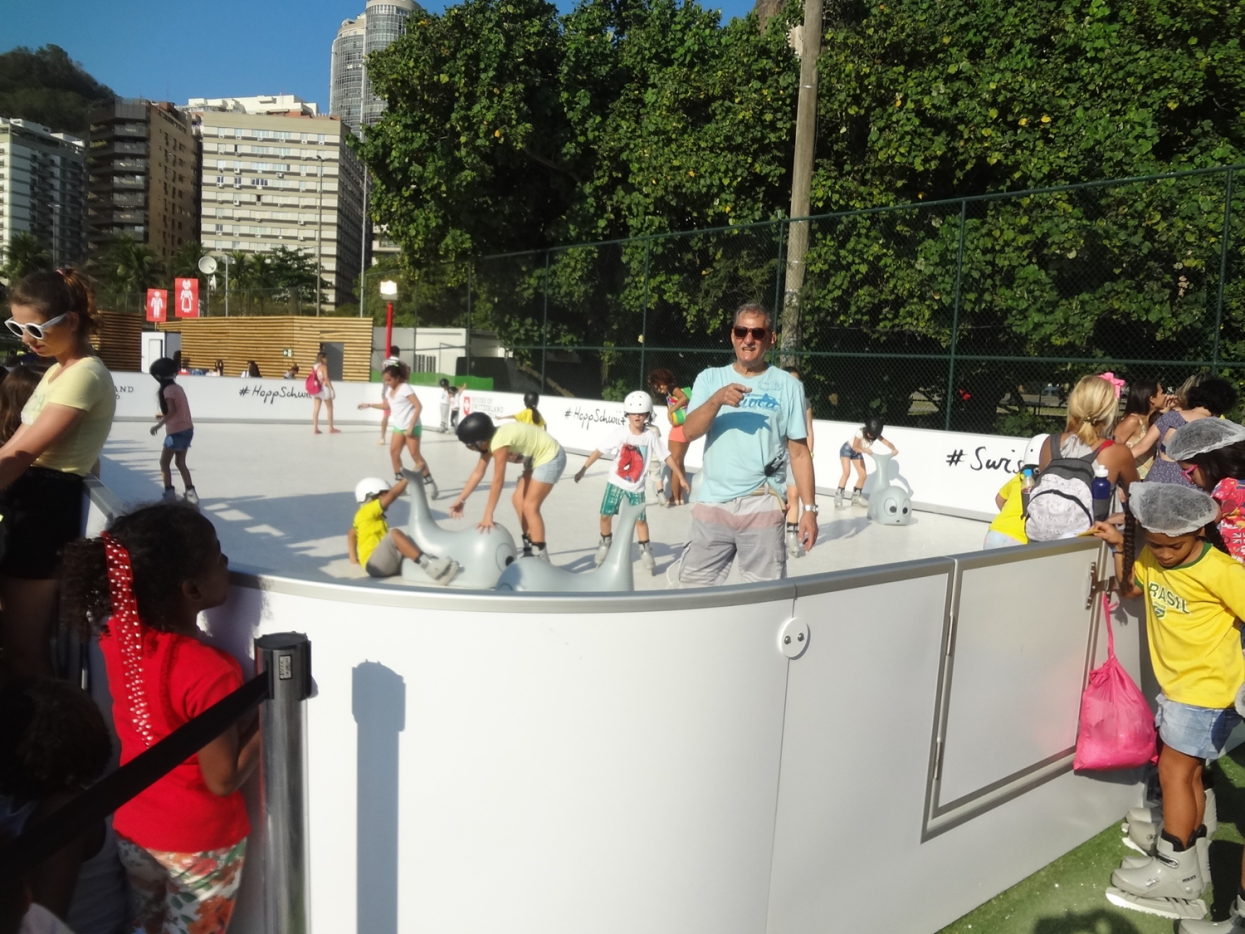
"Casa Africa" was jointly created by Africa's fifty-four countries. It was an exhibit in a rented area of a shopping center. In a mini-theater shaped like a plane one could watch African sightseeing videos.
The "Tokyo 2020 Japan House" was in the cultural complex Cidade das Artes, located in the Barra area. On the first floor was an exhibit corner introducing Tokyo 2020, Tokyo itself, and Japan's attractive aspects. On the second floor was an area in which one could experience Japanese culture, including tea ceremony, yukata, calligraphy, and yōyō (small balloons filled with air and water used at festivals). Furthermore, on the first floor stage many events were held. In this way, the house offered content that could be enjoyed by the general public.
What hints can we gather from the above unfolding of Rio 2016? In 2014 I presented "Design for Future," *30 a cultural policy for Tokyo 2020. Part of it included the proposal to develop a headquarters with the cooperation of international arts foundations. I described it as follows: "Bring the Asia headquarters of public and private cultural foundations to Japan. In order to do so, the Japanese government and regional governments would lease at no charge for the long term land for these buildings, as well as subsidize part of the costs of international building design competitions and construction expenses. Each headquarters would have an open space in which the works of countries' artists would be on display. Doing so would lead international artists, expert human resources in the field of culture, as well as capital to be brought to Japan."
*30: Yoshiyuki Oshita, "Design for Future, From 2020 to 22th: 2020 nen oyobi 2020 nen ikō o misueta bunka fukkō hōsaku" [Design for Future, From 2020 to the 22nd Century: A Cultural Revitalization Policy With an Eye to 2020 and Later] (July 2014).
Adding some antropofagia to my proposal, we could have public and private cultural foundations from throughout the world collaborate with Japan's Association for Corporate Support of the Arts. For example, would it not be interesting if, as part of the cultural program, the Foundation Cartier for Contemporary Art and Shiseido collaborated to turn a Yanaka machiya townhouse into the "Casa France"? As we approach 2020, it is my hope that such cultural fusions begin to appear throughout Tokyo.
(3) Jogo de Cintura and Hints for Tokyo 2020
Translated literally, jogo de cintura means to "play with the waist." It appears that it is used to refer to soccer plays characterized by flexible hip movement. In short, it means to do things flexibly instead of sticking excessively to the rules.
For example, with regard to the aforementioned "Rio Cultural Passport," at first the city tried to make its name be "Olympic Cultural Passport." However, the IOC did not give them permission to use "Olympic" in the name. However, the official Olympic logo was used in four spots on the passport (back cover, last page, etc.), and on the front were five colored lines that brought it to mind. Even though, as described earlier, multiple private cultural facilities participating in its system are listed on the passport, it became possible for them to use the official logo. This is nothing other than jogo de cintura, this approach can provide a many hints for Tokyo 2020.
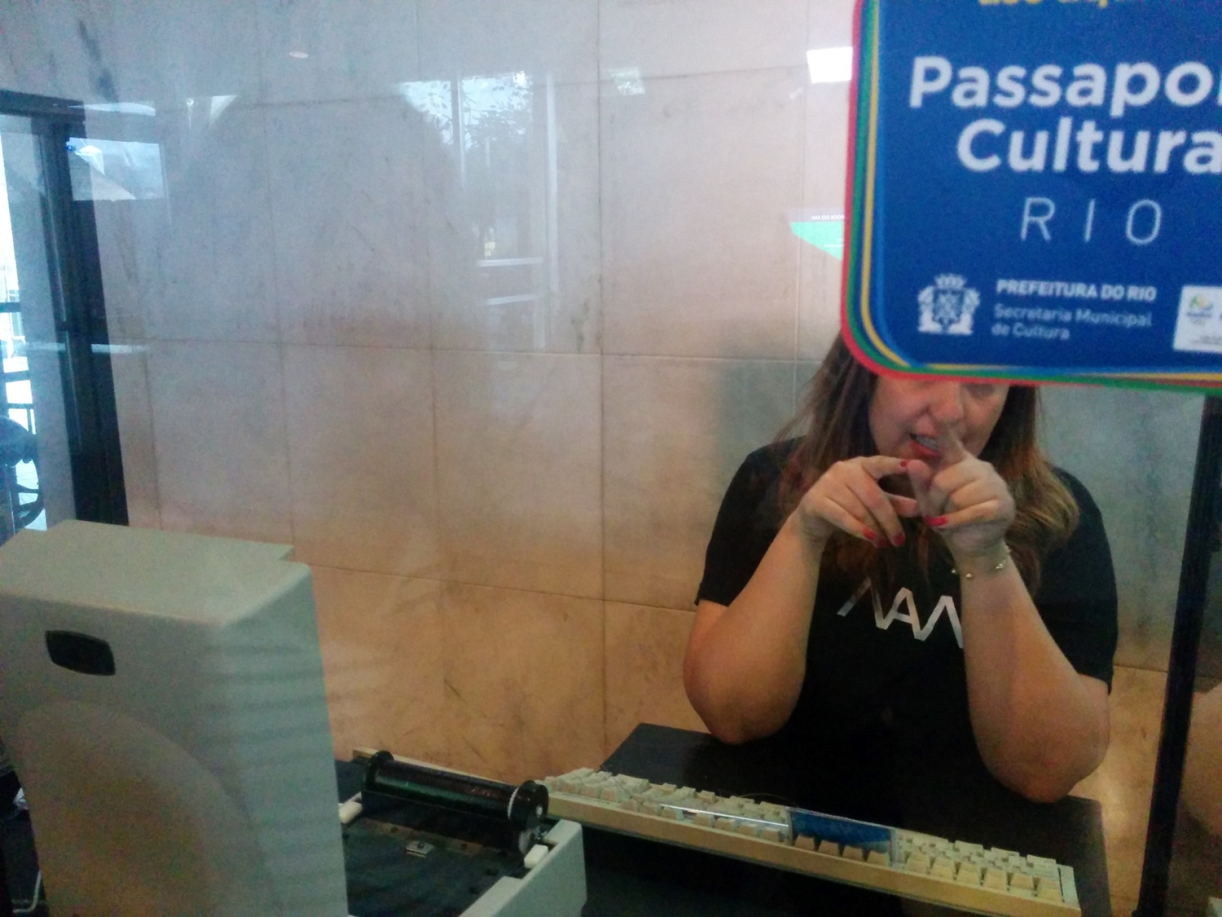
In August 2016 the guidelines for "Tokyo 2020 Participating Programs" were released. For these programs, a "mechanism (involving certification and permission to use a mark)" is being established "by which in preparation for the games various organizations and groups can, while being connected to the Olympics and Paralympics, carry out activities for participation, momentum, and legacy creation." The guidelines specify eight fields for projects, such as culture, sports, and health. Programs are also classified into two major categories: "Tokyo 2020 Official Programs" and "Tokyo 2020 Supporting Programs."
The former programs are allowed to use a mark indicating their official status. However, they can only be carried out by the government (its various ministries and other agencies), the hosting municipalities (Tokyo Metropolitan area, wards, cities, towns, and villages), sponsors, JOC, JPC, venue-related municipalities (prefectures, cities/town), and the holders of event broadcasting rights.
The latter kind of program, on the other hand, is not officially recognized. They are programs run by NPOs and the like for "aiming to expand the scope of [the aforementioned] activities and enabling many people participate." This is the equivalent of the Inspire program that took place during the London games, which featured non-commercial projects and played a major role. (Oshita 2016) *31
The Inspire logo "used the London 2012 logo without the Olympic rings, which facilitated the inclusion and recognition of a wider diversity of cultural organisations than had been possible in previous games." Furthermore, "This was the first time in a Games edition that the Cultural Olympiad visual identity was exclusively a variation on the main Games logo rather than a different pictogram . . . The most significant distinction within two of these Cultural Olympiad marks was the elimination of the 'Olympic rings': the Inspire programme and the London 2012 Festival . . .The 'no rings' but 'one logo' approach had two main positive effects in terms of bringing culture to the heart of the Games. First, it made it easier for a wide variety of culture stakeholders, including businesses, to find ways of creating an association with the Games that did not conflict with the commercial interests of IOC global sponsors." For Tokyo 2020 as well, a method has been adopted in which a shared logo was used for both official and supporting programs, while leaving the five rings out of that of the latter.
*31: Yoshiyuki Oshita, "Orinpikku bunka puroguramu ni kansuru kenkyū oyobi 'chiikiban ātsu kaunshiru' no teigen" [Cultural Programs Held in Conjunction with the Olympic Games and a Proposal for Regional Arts Councils] (2015).
However, at present the cultural organizations that can apply to run a non-profit "Tokyo 2020 Support Program" are limited. They include the Japan Arts Council, Japan Foundation, Tokyo Metropolitan Foundation for History and Culture, and Geidankyo. While there are plans to gradually increase the number of organizations that can apply, with this limited unfolding it will take some time before the scope of activities are expanded and many people are able to participate.
I am of the opinion that rather than this limited approach, one should be adopted in which as a general rule any non-profit organization can apply. If there are doubts whether a group is non-profit, this could be judged by an institute to which experts belong, such as the Association for Corporate Support of the Arts.
At the London Games, various groups and organizations participated in the Inspire program, and over one hundred seventeen thousand cultural projects (officially one hundred seventy-seven thousand projects) were carried out. However, currently the Japan's program is rather limited in scope, and there is the concern that the Ministry of Culture's goal of two hundred thousand projects will not be reached even if the number of Tokyo 2020 Official Programs and Tokyo 2020 Supporting Programs are combined. It appears in light of this situation the Cabinet Office is considering allowing projects to use a completely different mark than the "official" and "supporting" ones described above. However, how much value will people find in a mark that does not bring to mind the Olympics at all?
I think there is also a completely different solution that could be used: official (and supporting) Olympic programs serving as "platforms." These platforms could be a mechanism by which various other (un)official programs participate. If many non-profit programs will at any rate not be able to use a logo that brings to mind the five rings mark or the Olympics, after having established projects led by famous artists and the like as "official " or "supporting" programs, platforms based on these Tokyo 2020 Participating Programs would accommodate various other programs so that they could join in.
Figure 18: Tokyo 2020 Participating Programs as Platforms
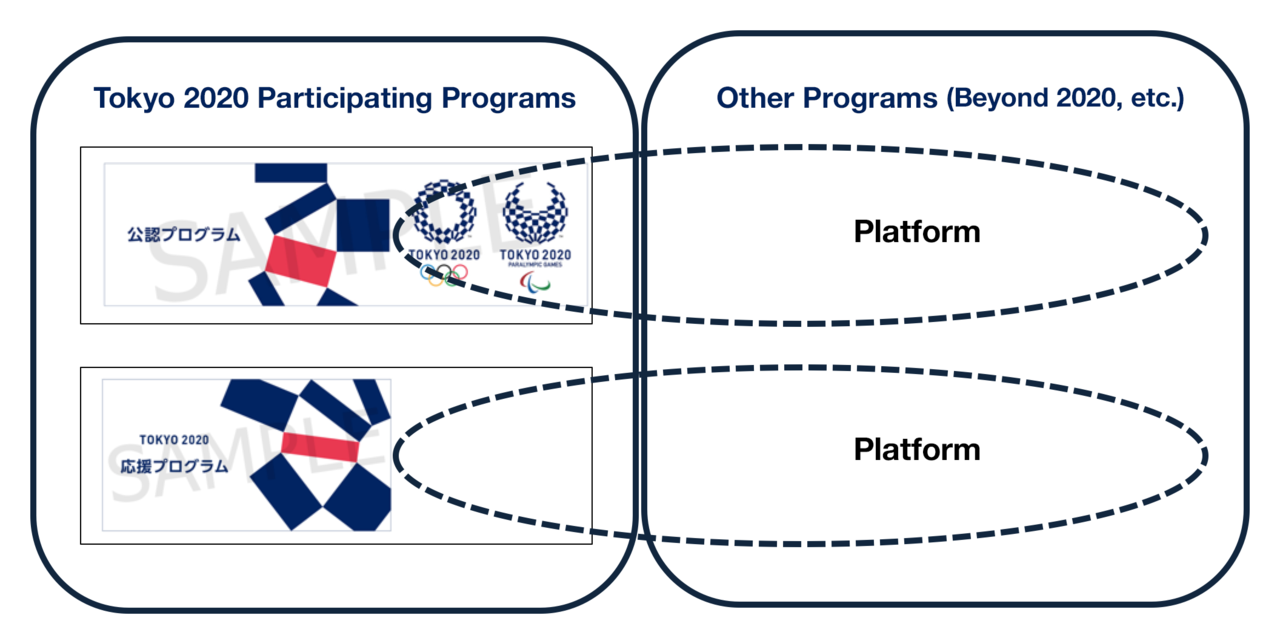
A project that can serve as a useful reference was carried out at Rio 2016: the famous "TURN" art project carried out under the direction of the artist Katsuhiko Hibino. Four other artists in addition to Hibino participated, and works born from interactions they had while visiting San Paulo welfare facilities and the like were put on display. In other words, TURN had two faces; it both was an art program by Hibino and functioned as a platform for four other artists.
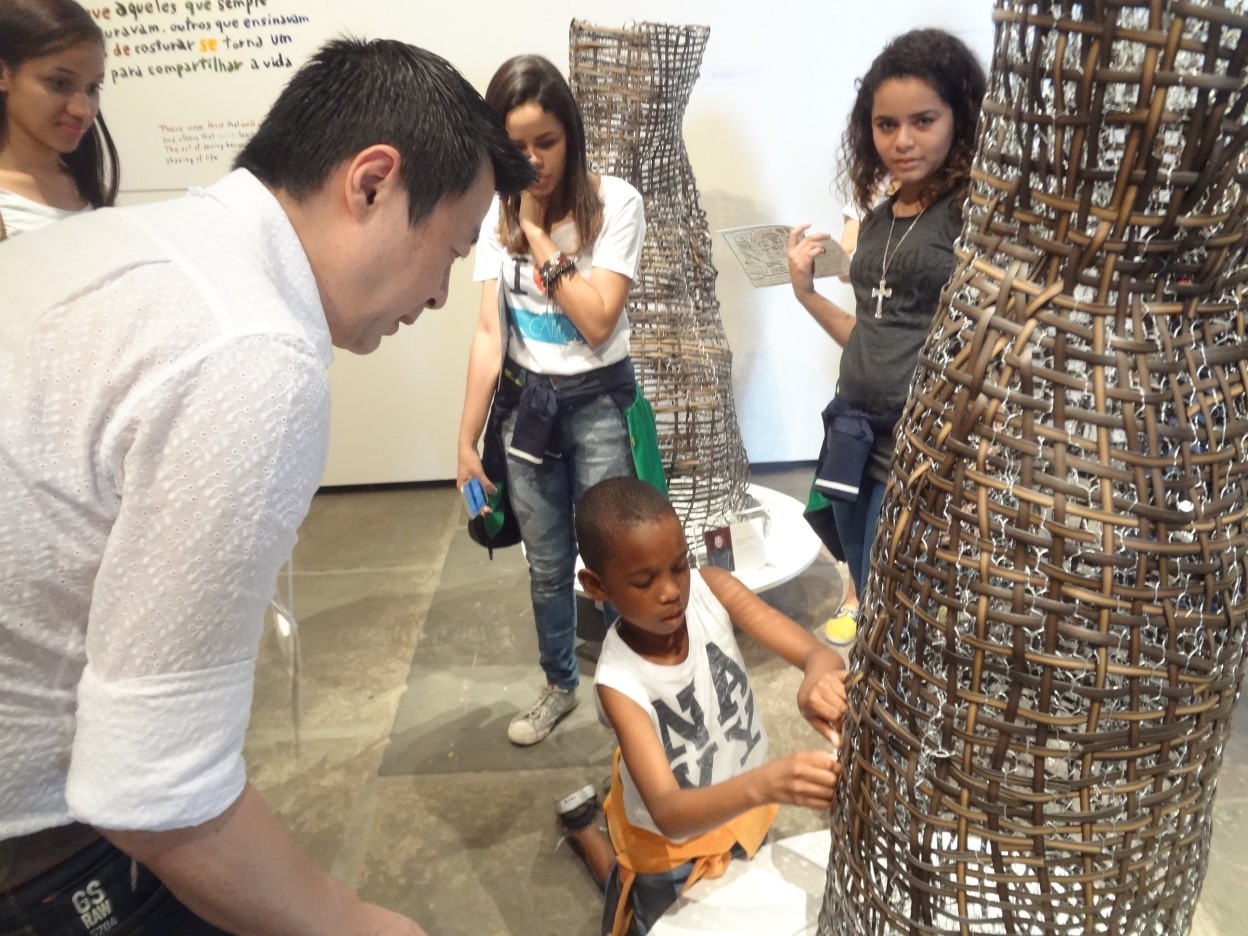
While the number of events comprising a cultural program is not what is important, the government has already adopted the goal of "twenty thousand," and therefore I have chosen to consider how this can be reached. If, for example, there were one hundred platforms like TURN and one hundred programs participated within each of them, then there would be a total of ten thousand programs. Since a single project would include multiple programs, the number of programs would be around one hundred thousand.
As described above, though, there was no coordination and cooperation between cultural program stakeholders for Rio 2016. For Tokyo 2020, it will be necessary to have a mechanism that consolidates information regarding its cultural programs. However, in Japan there is no nation-wide specialized organization like Britain's Arts Council, and it is unrealistic to try to create one. With this in mind, the most suited approach for Japan during Tokyo 2020 would be to not have over-concentrated management but rather aim for diversification, constructing various art platforms throughout Japan and turning them into a loose network.
As I write this, the international conference "World Forum on Sport and Culture" is being held in Kyoto and Tokyo, and it is expected that it will serve as a kickoff for the Olympic cultural programs. We will need to examine concretely how they unfold in Tokyo and other areas.
In future analyses, it will be necessary to keep in mind that cultural programs do not simply consist of events. The IOC emphasizes "legacy," a concept that refers to passing down heritage to the next generation. In the 1964 Olympics, Japanese design received international acclaim thanks to Yusaku Kamekura's poster for the games, leading to the profession of "designer" to take root in Japanese society. What kind cultural programs will be carried out, and what will be their intended legacy? Japan's wisdom is being tested as 2020 approaches.
(October 18th, 2016)



